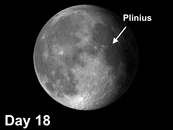The week of October 5-11 takes us from Lunar Day 18 to Day 24. This week we will highlight the crater Plinius, viewable on Monday and Tuesday evenings.
 Plinius: [NE/H12] Standing sentinel between Tranquillity and Serenity is the crater Plinius, a fine object with a sharp rim, terraces, an ejecta blanket, and a central projection which, depending on the illumination, has been described variously as a mountain, a double-mountain, central craters, or low mounds. How does it strike you?
Plinius: [NE/H12] Standing sentinel between Tranquillity and Serenity is the crater Plinius, a fine object with a sharp rim, terraces, an ejecta blanket, and a central projection which, depending on the illumination, has been described variously as a mountain, a double-mountain, central craters, or low mounds. How does it strike you?
 Immediately to the north of Plinius are three prominent rilles (Rimae Plinius), which follow along the edge of the Serenity basin. The lava that filled Serenity was so heavy that it not only affected Posidonius and le Monnier to its north, but substantial cracks opened up near Plinius over 200 miles away.
Immediately to the north of Plinius are three prominent rilles (Rimae Plinius), which follow along the edge of the Serenity basin. The lava that filled Serenity was so heavy that it not only affected Posidonius and le Monnier to its north, but substantial cracks opened up near Plinius over 200 miles away.
Although the lavas covering Serenity have a brighter hue, can you see that the lava plains of Mare Tranquillitatis are darker and older? The coloring becomes suddenly lighter just north of Plinius.
======================
It is highly recommended that you get a copy of Sky and Telescope’s Field Map of the Moon, the very finest Moon map available for use at the telescope. It is available for $10.95 at www.skyandtelescope.com and on Amazon. All features mentioned in this blog will be keyed to the grid on the Field Map and will look like this: Plato: [NW/D9]
Credits:
Courtesy of Gray Photography of Corpus Christi, Texas
Lunar photos: NASA / USGS / BMDO / LROC / ASU / DLR / LOLA / Moon Globe. Used by permission
- Rupes Cauchy: A Best Known Fault on the Moon - July 22, 2024
- Moon Crater Schickard – Crater Floor has Stripes - July 15, 2024
- Moon Craters Langrenus and Vandelinus - July 8, 2024
Hi Andrew,
This is a note to thank you for your fine blog and book.
In 2014, I broke my head, severing the left audio nerve and bruising the two balance nerves. Result? I have a severe balance problem, especially at night (when we like to observe!).
It turns out that the bane to deep sky observers is very welcome to me: my colleagues put up their gear when the moon shines. Me? There is just enough light to make up for the loss of balance sensation: I use *visual* input to orient myself spatially!
And then along came Andrew Planck!
Deep sky observing and faint fuzzies? Naaaa. How about a Televue 60 and Meade ETX 90 for lunar viewing.
Thank you.
John Sosville